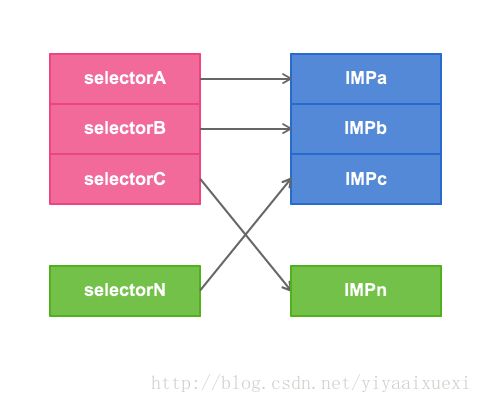Objective-C黑魔法使用适当能给编码带来很大的便利,Swizzling就是其中之一。比如集成友盟统计时,如果按照常规方法来做的话,需要在每个页面打点,页面多多话,这不搞死人吗?有没有一个简便的方法能够一劳永逸尼,答案就是Swizzling。利用Objective-C的动态特性,在运行时把原本selector对应的实现绑定到我们指定的实现来。
一.应用场景:
1.数组越界判断
2.可变字典插入空元素
3.集成友盟统计时,不必在每个控制中添加代码
二.到底怎么用:
每一个类都有对应的类方法列表,以及实例方法列表,selector的名字和方法实现是一一对应的关系,IMP类似函数指针,每个selector都对应一个IMP。如下图:
在
method_exchangeImplementations方法,可以改变selector指向的IMP',,说白了,我们就是要改变selector的实现。比如在友盟统计中,我们需要在
- (void)viewWillAppear:(BOOL)animated 中打点。其实我们可以把打点的代码写在父类中,然后让需要打点的页面都继承这个父类,但是工作量就比较大,而且代码恶心。
最优解就是我们定义一个Category,在这个Category中,偷偷
- (void)viewWillAppear:(BOOL)animated中的实现指向另一个我们预想的IMP。
我们必须在方法没有执行之前把它的实现替换掉,否则就没有意义了,那么在那个时机替换实现尼?'+(void)load'方法APP启动前就被调用了,并且它在整个程序生命周期里只执行一次,所以我们可以在这里搞点小动作。我们可以打断点验证一下的,新建一个iOS工程,分别在
+(void)load,
int main(int argc, char * argv[]) {},
- (BOOL)application:(UIApplication *)application didFinishLaunchingWithOptions:(NSDictionary *)launchOptions
这三个方法里打断点,发现程序是按照-->load-->main-->didFinishLaunchingWithOptions:的顺序来执行的,也是说我们的把替换代码写在+(void)load中是正确的。
废话少说,直接上代码
#import "UIViewController+Swizzling.h"
#import
@implementation UIViewController (Swizzling)
+(void)load{
//虽然load只执行一次,但是为了保险起见,我们还是给加个dispatch_once吧,良好的编程习惯,从这里开始
static dispatch_once_t token;
dispatch_once(&token, ^{
SEL orginSel = @selector(viewWillAppear:);
SEL overrideSel = @selector(overrideViewWillAppear:);
Method originMethod = class_getInstanceMethod([self class], orginSel);
Method overrideMethod = class_getInstanceMethod([self class], overrideSel);
//原来的类没有实现指定的方法,那么我们就得先做判断,把方法添加进去,然后进行替换
if (class_addMethod([self class], orginSel, method_getImplementation(overrideMethod) , method_getTypeEncoding(originMethod))) {
class_replaceMethod([self class],
overrideSel,
method_getImplementation(originMethod),
method_getTypeEncoding(originMethod));
}else{
//交换实现
method_exchangeImplementations(originMethod, overrideMethod);
}
});
}
- (void)overrideViewWillAppear:(BOOL)animation{
NSLog(@"%@-----overrideViewWillAppear",self);
//这里并不会造成死循环,因为这个时候是去调用原来的ViewWillAppear:(BOOL)animation方法了。
[self overrideViewWillAppear:animation];
}
借用这个图来说明一下为什么-(void)overrideViewWillAppear:(BOOL)animation里调用自身不会死循环。
-viewWillAppear (SEL) -> -overrideViewWillAppear (IMP)-> [self overrideViewWillAppear:animation] (SEL) -> -viewWillAppear(IMP)
这个流程就一目了然了,当页面将要出现时调用-viewWillAppear,但是这个方法的实现已经被我们换了,最终会掉到我们调前写好的方法-overrideViewWillAppear,但是我们通过self来调用-overrideViewWillAppear时,却又走的是-viewWillAppear,所以不会出现死循环。
所以最终我们在overrideViewWillAppear里面添加了打点得代码,并且还能不影响已经在-viewWillAppear添加的代码。
另外一个iOSer的痛点就是,我们在给可变字典添加元素时,一不小心就奔溃了,额,也是挺奔溃的啊~。其中的一个原因是添加到字典的value为nil了。刚好我们可以用刚刚学的的钩子,解决这个问题。思路就是每次调用 setObject:forKey:的时候,我们偷偷的得对Object做一个非空判断,如果为空就不给添加到字典里面来。
思路有了,那开始码代码了。
#import "NSMutableDictionary+Swizzling.h"
#import
@implementation NSMutableDictionary (Swizzling)
+ (void)load
{
static dispatch_once_t token;
dispatch_once(&token, ^{
SEL orginSel = @selector(setObject:forKey:);
SEL overrideSel = @selector(overrideSetObject:forKey:);
Method originMethod = class_getInstanceMethod([self class], orginSel);
Method overrideMethod = class_getInstanceMethod([self class], overrideSel);
//原来的类没有实现指定的方法,那么我们就得先做判断,把方法添加进去,然后进行替换
if (class_addMethod([self class], orginSel, method_getImplementation(overrideMethod) , method_getTypeEncoding(originMethod))) {
class_replaceMethod([self class],
overrideSel,
method_getImplementation(originMethod),
method_getTypeEncoding(originMethod));
}else{
//交换实现
method_exchangeImplementations(originMethod, overrideMethod);
}
});
}
- (void)overrideSetObject:(id)anObject forKey:(id )aKey;
{
if (anObject) {
NSLog(@"%@--overrideSetObject",self);
/** 注意:必须调用自己的方法名 */
[self overrideSetObject:anObject forKey:aKey];
}
}
@end
我们使用一下这个分类试试
NSMutableDictionary *dic = [[NSMutableDictionaryalloc]init];
[dic setObject:@"testObject"forKey:@"myKey"];
结果发现- (void)overrideSetObject:(id)anObject forKey:(id 这个方法根本就没有被调用。原因何在尼?原来NSMutableDictionary是一个族类(关于族类建议参考《Effective Objective-C 2.0 编写高质量iOS与OS X代码的52个有效方法》第九条),我们代码里通过[selfclass]返回的是当前类的类名,也就是NSMutableDictionary,而实际上应该是__NSDictionaryM (dic __NSDictionaryM * 1 key/value pair 0x00007f84a4f0daf0)(在控制台中po一下这个dic就能看出来了,这个dic的类型是__NSDictionaryM)。所以我把以上代码改一下:
+ (void)load
{
static dispatch_once_t token;
dispatch_once(&token, ^{
SEL orginSel = @selector(setObject:forKey:);
SEL overrideSel = @selector(overrideSetObject:forKey:);
Class o_class = objc_getClass("__NSDictionaryM");
Method originMethod = class_getInstanceMethod(o_class, orginSel);
Method overrideMethod = class_getInstanceMethod(o_class, overrideSel);
//原来的类没有实现指定的方法,那么我们就得先做判断,把方法添加进去,然后进行替换
if (class_addMethod(o_class, orginSel, method_getImplementation(overrideMethod) , method_getTypeEncoding(originMethod))) {
class_replaceMethod(o_class,
overrideSel,
method_getImplementation(originMethod),
method_getTypeEncoding(originMethod));
}else{
//交换实现
method_exchangeImplementations(originMethod, overrideMethod);
}
});
}
run一下发行可以了。
在cocoa框架里面数组和字典这样的族类,最终初始化出来的实例的类型,并不是预想的,下图才是它们的’真身’
类 “真身”
NSArray __NSArrayI
NSMutableArray __NSArrayM
NSDictionary __NSDictionaryI
NSMutableDictionary __NSDictionaryM
三.不足
在程序启动的时候,系统也会多次调用setObject:forKey:方法,从而也会调用我们写的那个钩子,所以感觉还不算完善,毕竟系统调用的,我们管不着了。


